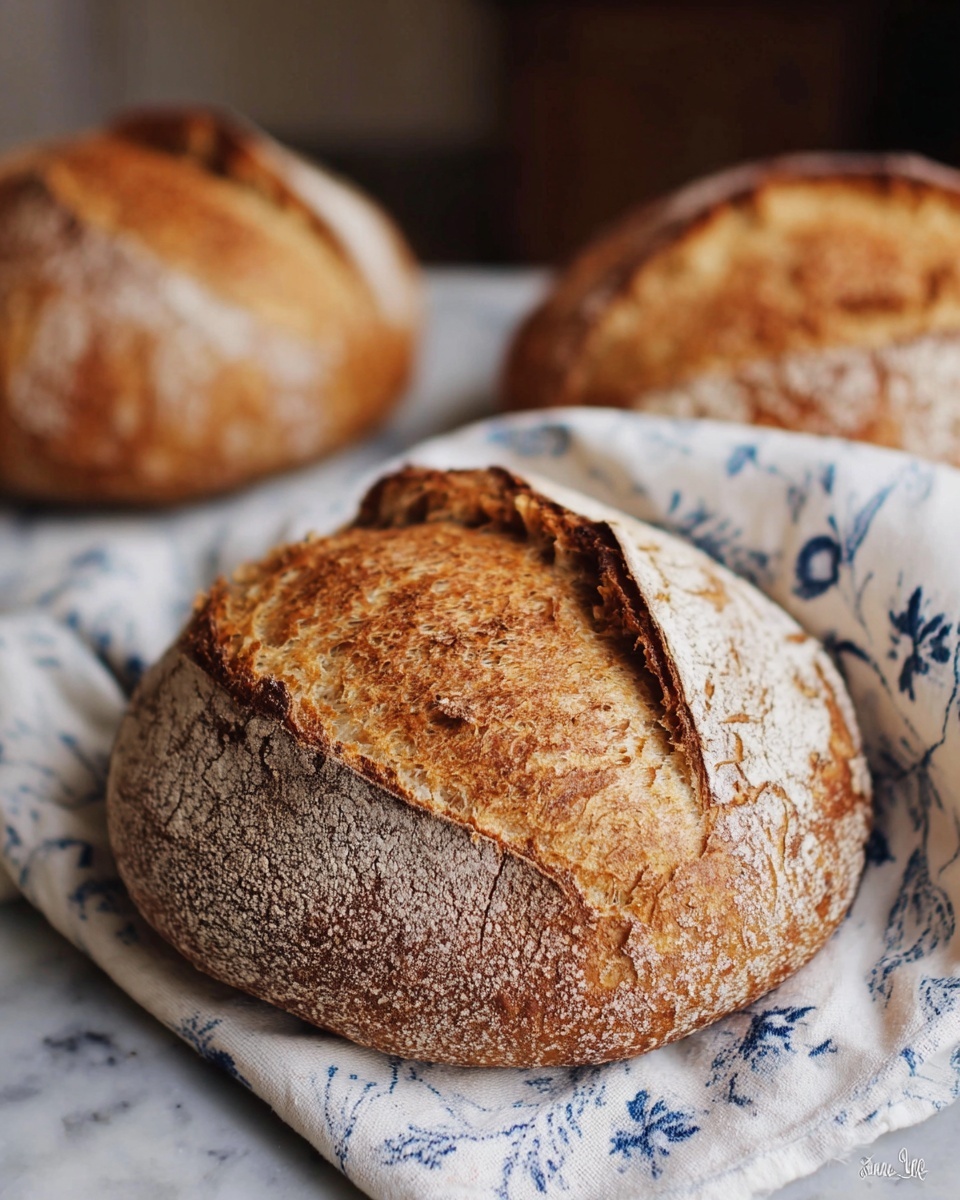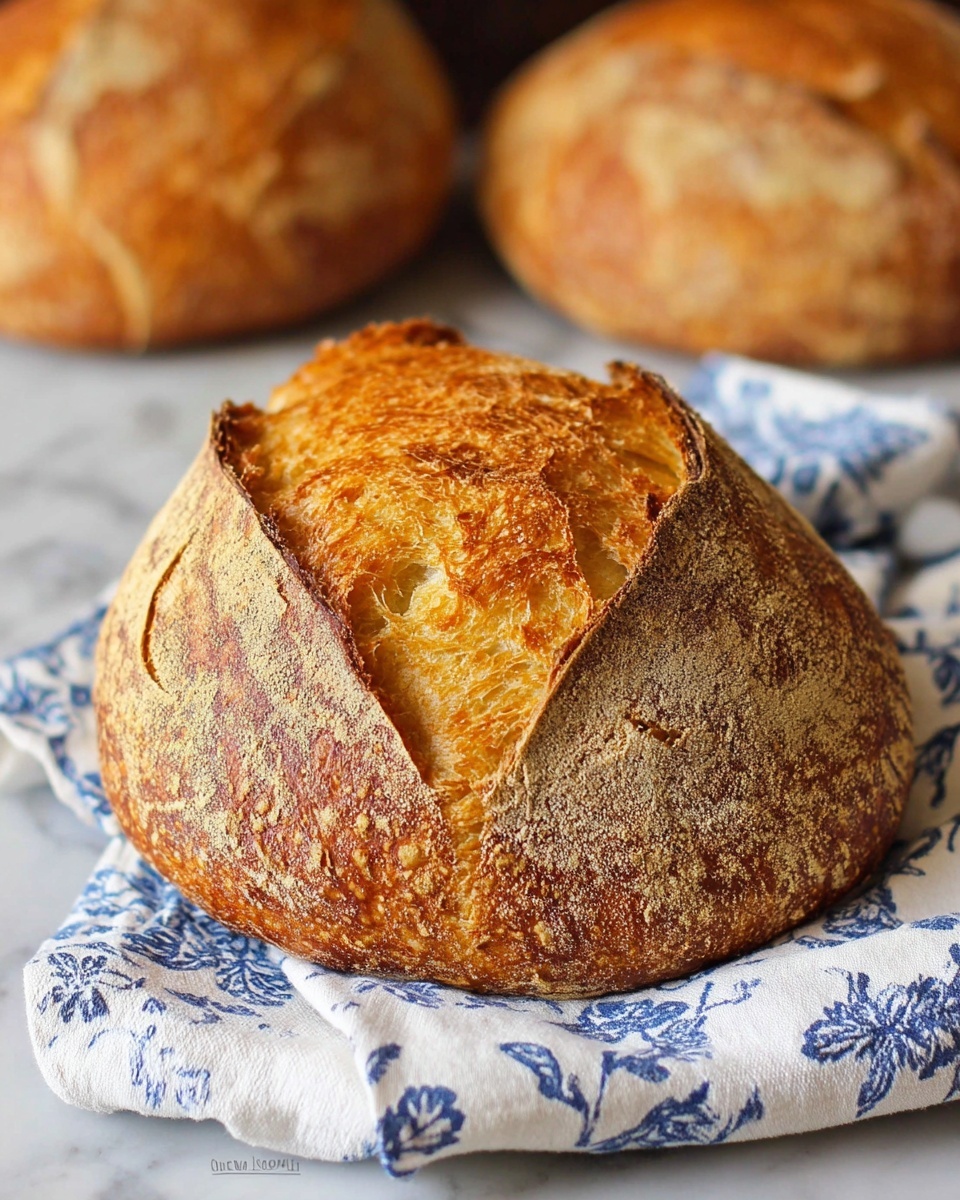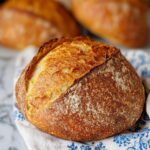If you have been searching for that perfect, tangy loaf to elevate your homemade bread game, look no further than this Sourdough Bread Recipe. It captures the essence of traditional bread-making with its irresistibly crisp crust and tender, flavorful crumb, bringing a warm, rustic touch to your kitchen. This recipe not only teaches you the art of sourdough but invites you into a rewarding journey of delicious discovery that turns simple ingredients into something truly spectacular.

Ingredients You’ll Need
The magic of this Sourdough Bread Recipe lies in the simplicity and quality of its ingredients. Each component plays a crucial role—from the earthy depth of rye flour to the active sourdough starter that breathes life into the dough, ensuring incredible flavor and texture.
- 400 g bread flour: Provides strong gluten structure for that chewy, airy crumb.
- 55 g rye flour: Adds a subtle tang and complex taste; whole wheat or bread flour can be used as substitutes.
- 10 g fine sea salt: Enhances flavor and controls fermentation.
- 345 g filtered water: Helps develop the dough’s hydration, using filtered or dechlorinated water at lukewarm temperature is essential for starter activity.
- 100 g active sourdough starter: Acts as the natural leavening agent and flavor powerhouse.
- Rice flour (optional): Perfect for dusting your bread basket to prevent sticking and add a decorative touch to your loaf.
How to Make Sourdough Bread Recipe
Step 1: Feed Your Starter
Before you dive into making the bread, feeding your sourdough starter is key to ensure it’s bubbly and active. Mix equal parts starter, bread flour, and lukewarm water—around 50g each—and let it rise at room temperature until it more than doubles, typically 4 to 6 hours. This step turbocharges the natural yeast, setting the stage for a lively and flavorful loaf.
Step 2: Make the Dough
Bring together your bread flour, rye flour, and salt in a large mixing bowl, whisking to combine. Add the measured water and that lively sourdough starter, then mix thoroughly with a wooden spoon. When it starts to come together, switch to your hands for a thorough pinch and fold, embracing the sticky feel—that’s a good sign! Cover the bowl and let the dough rest for a leisurely 4 hours at room temperature. This period allows the flour to hydrate and enzymes to develop complex flavors.
Step 3: Bulk Fermentation and Stretch & Fold
Every hour during your 4-hour bulk fermentation, perform a round of “stretch and fold.” Wet your hands to prevent sticking, gently lifting one side of the dough upwards and folding it over itself. Repeat this around the dough, rotating the bowl, and continue until the dough resists stretching. This technique strengthens the gluten network and helps develop that characteristic sourdough texture and rise.
Step 4: Shape the Loaf
Once bulk fermentation wraps up, turn the sticky dough onto a lightly floured surface. Using floured hands, gently stretch and shape the dough to fit your banneton, which molds the loaf and encourages an elegant rise during baking. If doubling the recipe, divide the dough before shaping.
Step 5: Bench Rest
Place the shaped dough seam-side down, cover with a towel, and allow it to rest for 20 minutes. This brief rest relaxes the gluten, making it easier to tighten and shape in the next step.
Step 6: Tighten the Dough
If the dough has slackened during the bench rest, no worries. Simply cup your floured hands around it, tucking the edges underneath while gently pulling the dough toward you in a circular motion. This action tightens the loaf, creating surface tension that helps maintain a beautiful shape.
Step 7: Cold Fermentation
Transfer the tightened dough seam-side up into your floured banneton, dusting it with rice flour if you like for that eye-catching artisanal look. Cover with a tea towel and refrigerate for at least 8 hours or up to 48 hours. This slow chill enhances flavor complexity and makes the dough easier to handle when baking time arrives.
Step 8: Preheat the Oven
About 30 minutes before baking, place your Dutch oven or combo cooker in the oven and preheat to a blazing 500 degrees Fahrenheit. If you’re using a pizza stone, set that on the bottom rack to ensure a solid heat base for perfect crust development.
Step 9: Score your Bread
When you’re ready to bake, tip the dough out onto parchment paper or into a bread sling. Using a lame or sharp knife, score a crescent-shaped slash at a 45-degree angle around the top, about one-third to one-half inch deep. This not only creates beautiful oven spring but also directs how the bread expands as it bakes.
Step 10: Bake
Carefully cover your bread with the preheated Dutch oven lid and slide it into the oven. Immediately reduce the heat to 450 degrees Fahrenheit and bake covered for 20 minutes. Then remove the lid and bake uncovered for an additional 20 to 25 minutes until the crust boasts your desired golden-brown color and crispness. The aroma at this point is utterly irresistible!
How to Serve Sourdough Bread Recipe

Garnishes
While the bread itself is a star, a few garnishes can take your presentation to the next level. Lightly brush the crust with melted butter or a drizzle of high-quality olive oil for a glossy finish and layered flavor. Sprinkle flaky sea salt or herbs like rosemary for an inviting aroma and an extra punch of taste.
Side Dishes
Sourdough bread pairs beautifully with robust, comforting sides. Think creamy soups such as tomato bisque or butternut squash, or a classic cheese board featuring sharp cheddar, nutty gouda, and tangy blue cheese. Freshly made dips like hummus or artichoke spread add delightful textures that highlight the crumb’s open pockets.
Creative Ways to Present
Get adventurous and transform your loaf into star-worthy presentations. Hollow it out to create a rustic bread bowl for stews or dips, slice thick and toast for hearty sandwiches, or turn slices into croutons to crown salads and soups. Each method showcases the bread’s versatility and delicious tang.
Make Ahead and Storage
Storing Leftovers
To keep your sourdough fresh, store leftovers at room temperature wrapped in a clean kitchen towel or paper bag. This breathable method preserves the crust’s crunch while preventing excess moisture buildup. Avoid plastic bags as they tend to trap moisture and soften the crust.
Freezing
If you want to enjoy your Sourdough Bread Recipe for longer, freezing is a fantastic option. Slice the loaf and freeze the pieces in airtight freezer bags. This way, you can toast slices directly from frozen without sacrificing taste or texture.
Reheating
To revive your bread’s crispy crust and warm crumb, heat it in a preheated oven at 350 degrees Fahrenheit for about 10 minutes. For sliced bread, a toaster also works wonders, bringing back that irresistible crunch and softness inside.
FAQs
Can I use all-purpose flour instead of bread flour for this Sourdough Bread Recipe?
Yes, you can substitute all-purpose flour, but your loaf may be slightly less chewy and have a denser crumb due to the lower protein content. Adding a bit more kneading and hydration can help improve texture.
How do I know if my sourdough starter is active enough for baking?
An active starter will more than double in size within 4 to 6 hours of feeding and show plenty of bubbles. A simple float test—dropping a spoonful of starter into water to see if it floats—is also a good indicator.
Is it necessary to refrigerate the dough for cold fermentation?
Cold fermentation is highly recommended as it develops deeper flavor and improves dough handling, but if you’re short on time, you can bake after the bulk fermentation stage without refrigerating. Just expect a milder sour flavor.
What if I don’t have a Dutch oven or combo cooker?
You can bake the bread on a pizza stone with a separate steam source, like a pan of water in the oven, to mimic the moisture trap of a Dutch oven. This helps produce a crispy, crackly crust.
How do I prevent my sourdough bread from sticking to the banneton?
Dust the banneton generously with rice flour before placing the dough inside. Rice flour doesn’t absorb moisture like wheat flour and helps the dough release easily after proofing.
Final Thoughts
There is something truly special about creating your own sourdough bread, and this Sourdough Bread Recipe is a joyful way to embrace that experience. With its simple ingredients and approachable steps, you can enjoy the satisfaction of baking an artisanal loaf at home. Don’t wait to try it out—you will love the fragrant, crusty bread that becomes a staple in your kitchen and heart.
Print
Sourdough Bread Recipe
- Prep Time: 20 minutes
- Cook Time: 40 minutes
- Total Time: 8 hours 1 hour (including cold fermentation and folding intervals)
- Yield: 1 loaf
- Category: Bread
- Method: Baking
- Cuisine: French-inspired Sourdough
- Diet: Vegetarian
Description
This classic Sourdough Bread recipe yields a crusty and flavorful loaf made with a natural sourdough starter. Featuring a blend of bread and rye flours, the dough undergoes a slow fermentation process including stretch and folds, bench resting, and cold proofing for optimal texture and taste. Baked in a preheated Dutch oven at high heat, this bread boasts a crisp crust and chewy crumb perfect for sandwiches, toasting, or enjoying fresh with butter.
Ingredients
Flours
- 400 g bread flour (or all-purpose flour, plus more to dust)
- 55 g rye flour (or whole wheat or bread flour)
- Rice flour (optional, for dusting the bread basket)
Other Ingredients
- 10 g fine sea salt
- 345 g filtered water (or dechlorinated/spring water, lukewarm up to 85˚F)
- 100 g active sourdough starter
Instructions
- Feed the Starter: Feed your sourdough starter 1 or 2 times before making the bread to ensure it is active. Mix 50g starter with 50g bread flour and 50g lukewarm water. Cover loosely and let rise at room temperature until doubled in size, about 4-6 hours.
- Make the Dough: In a large bowl, whisk together bread flour, rye flour, and salt. Add water and sourdough starter. Stir with a wooden spoon then mix thoroughly by hand, pinching the dough to combine well. The dough will be sticky. Scrape down bowl, cover with a towel, and let rest at room temperature for 4 hours.
- Bulk Fermentation Stretch and Fold: Every hour during the 4-hour bulk fermentation, perform a round of stretch and folds. With wet hands, gently lift and stretch one side of the dough upwards without tearing, then fold it over itself. Rotate the bowl quarter turn and repeat about 3 more times until the dough resists pulling. Keep covered between rounds. After the final (fourth) fold, let it rest.
- Shape the Loaf: Turn dough onto a lightly floured surface. If doubled for 2 loaves, cut in half. Gently stretch and shape dough to fit your banneton (bread basket) or baking pot.
- Bench Rest: Place dough seam-side down, cover with a towel, and let rest for 20 minutes to relax and slightly proof.
- Tighten the Dough: If the dough loosens during bench rest, gently reshape to tighten. Cup hands around dough edges, tuck the sides underneath, and pull the dough down the counter in a circular motion to create tension.
- Cold Fermentation: Transfer dough seam-side up into a banneton dusted with rice flour. Cover with a tea towel and refrigerate for at least 8 hours up to 48 hours to develop flavor and improve texture.
- Preheat the Oven: Place a Dutch oven or combo cooker (and optionally a pizza stone on the bottom rack) in the oven and preheat to 500°F at least 30 minutes before baking.
- Score the Bread: Turn the dough out onto parchment paper or a bread sling. Using a bread lame, score a 1/3 to 1/2 inch deep crescent shape around the top of the bread at a 45-degree angle starting at the base on one side. Transfer dough with parchment into the Dutch oven if using.
- Bake: Cover with the preheated lid and place into the oven. Immediately reduce oven temperature to 450°F. Bake covered for 20 minutes, then remove the lid and bake uncovered for an additional 20-25 minutes until the crust is deeply golden and desired color.
Notes
- Use filtered, dechlorinated, or spring water warmed to about 85˚F to encourage fermentation.
- Rye flour can be substituted with whole wheat or all bread flour if unavailable.
- Rice flour is ideal for dusting bannetons to prevent sticking without adding moisture.
- Bannetons can be replaced with a well-floured bowl if needed.
- Cold fermentation enhances flavor and texture; do not skip this resting step.
- Ensure oven and Dutch oven are fully preheated to achieve a good oven spring and crust.
- Handle dough gently to preserve air bubbles for a better crumb structure.
- Scoring controls oven expansion and adds decorative aesthetic.








